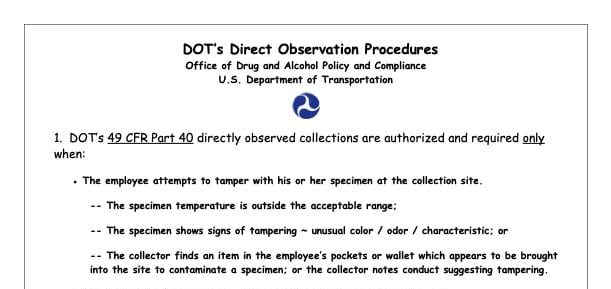It is not uncommon for people to try to defeat a drug test, either by substitution or adulteration. Substitution simply means they smuggle in someone else’s urine, or synthetic urine. Adulteration means they add an adulterant to their specimen which can make it invalid. To prevent this from occurring, sometimes an observer accompanies the individual into the restroom. Under DOT guidelines, Direct Observation for drug test is required in certain circumstances, and how it is performed is also very specific.
The following is from here: https://www.transportation.gov/odapc/dot-direct-observation-procedures
DOT’s Direct Observation Procedures1. DOT’s 49 CFR Part 40 directly observed collections are authorized and required only when:
- The employee attempts to tamper with his or her specimen at the collection site.
- The specimen temperature is outside the acceptable range;
- The specimen shows signs of tampering ~ unusual color / odor / characteristic; or
- The collector finds an item in the employee’s pockets or wallet which appears to be brought into the site to contaminate a specimen; or the collector notes conduct suggesting tampering.
- The Medical Review Officer (MRO) orders the direct observation because:
- The employee has no legitimate medical reason for certain atypical laboratory results; or
- The employee’s positive or refusal [adulterated / substituted] test result had to be cancelled because the split specimen test could not be performed (for example, the split was not collected).
- The test is a Follow-Up test or a Return-to-Duty test.
2. The observer must be the same gender as the employee.
3. If the collector is not the observer, the collector must instruct the observer about the procedures for checking the employee for prosthetic or other devices designed to carry “clean” urine and urine substitutes AND for watching the employee urinate into the collection container.
- The observer requests the employee to raise his or her shirt, blouse or dress / skirt, as appropriate, above the waist, just above the navel; and lower clothing and underpants to mid-thigh and show the observer, by turning around, that the employee does not have such a device.
- If The Employee Has A Device: The observer immediately notifies the collector; the collector stops the collection; and the collector thoroughly documents the circumstances surrounding the event in the remarks section of CCF. The collector notifies the DER. This is a refusal to test.
- If The Employee Does Not Have A Device: The employee is permitted to return clothing to its proper position for the observed collection. The observer must watch the urine go from the employee’s body into the collection container. The observer must watch as the employee takes the specimen to the collector. The collector then completes the collection process.
4. Failure of the employee to permit any part of the direct observation drug test procedure is a refusal to test.

